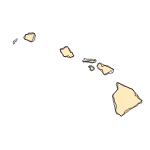Drepanotrema kermatoides
(crested ramshorn)
Mollusks-Gastropods
Exotic |
|
Common name: crested ramshorn
Taxonomy: available through
www.itis.gov
Identification: Drepanotrema kermatoides’ shell is extremely flat with multiple whorls making a spiral. The shell has numerous close-set, low spiral ridges (lirae) (Thorp and Covich 2010).
Size: 4-6 mm (diameter; Rumi et al. 2004)
Native Range: Caribbean region, Central America and South America



|

Alaska |

Hawaii |

Puerto Rico &
Virgin Islands |

Guam Saipan |
Hydrologic Unit Codes (HUCs) Explained
Interactive maps: Point Distribution Maps
Nonindigenous Occurrences:
South Laguna Madre, Texas (Turgeon et al. 1998) and Lower Aransas River, Texas (Ohio State University Mollusk specimen-20353)
Table 1. States with nonindigenous occurrences, the earliest and latest observations in each state, and the tally and names of HUCs with observations†. Names and dates are hyperlinked to their relevant specimen records. The list of references for all nonindigenous occurrences of Drepanotrema kermatoides are found here.
Table last updated 1/11/2026
† Populations may not be currently present.
Ecology: Drepanotrema kermatoides are pulmonate snails, which means that they have lungs rather than gills, and they are hermaphroditic. They become mature at year one for 60-80% of the population (Rumi et al. 2007). Reproduction occurs over most of the year in the snail's native range (Rumi et al. 2004, Rumi et al. 2007). Most often found in streams and rivers (Rumi et al. 2004), the species shows a high tolerance to environmental stress, including low dissolved oxygen environments (Rumi et al. 2007). Drepanotrema kermatoides are limited by saltwater (Vivar et al. 1996).
Drepanotrema kermatoides have been observed to have an affinity for free-floating macrophytes (Rumi et al. 2007).
Means of Introduction: Unknown, but likely a hitchhiker with aquatic plants (macrophytes).
Status: The current status of the introduced populations are unknown.
Impact of Introduction: The impacts of this species are currently unknown, as no studies have been done to determine how it has affected ecosystems in the invaded range. The absence of data does not equate to lack of effects. It does, however, mean that research is required to evaluate effects before conclusions can be made.
References: (click for full references)
Thorp, J.H., and A.P. Covich. 2010. Ecology and Classification of North American Freshwater Invertebrates (Third Edition). Academic Press, Elsevier Inc, San Diego, CA.
Turgeon, D.D., J.F. Quinn, Jr., A.E. Bogan, E.V. Coan, F.G. Hochberg, W.G. Lyons, P.M. Mikkelsen, R.J. Neves, C.F.E. Roper, G. Rosenberg, Barry Roth, A. Scheltema, F.G.Thompson, M. Vecchione, and J.D. Williams. 1998. Common and scientific names of aquatic invertebrates from the United States and Canada: mollusks. Second Edition. American Fisheries Society Special Publication 26.
Rumi, A., D. Gutiérrez Gregoric, M. Roche, and M. Tassara. 2004. Population structure in Drepanotrema kermatoides and D. cimex (Gastropoda: Planorbidae) in natural conditions. Malacologia 45: 453-458.
Rumi, A., G. Gutiérrez, and M.A. Roche. 2007. Growth rate fitting using the von Bertalanffy model: analysis of natural populations of Drepanotrema spp. snails (Gastropoda: Planorbidae). Revista de Biología Tropical 55(2):559-567.
Vivar, R., H. Larrea, P. Huaman, M. Yong, and G. Perera.1996. Some ecological aspects of the freshwater molluscan fauna of Pantanos de Villa, Lima, Perú. Malacological review 29: 65-68.
Author:
Daniel, W.M. and Morningstar, C.R
Revision Date: 9/27/2019
Peer Review Date: 9/27/2019
Citation Information:
Daniel, W.M. and Morningstar, C.R, 2026, Drepanotrema kermatoides (d'Orbigny, 1835): U.S. Geological Survey, Nonindigenous Aquatic Species Database, Gainesville, FL, https://nas.er.usgs.gov/queries/FactSheet.aspx?speciesID=2574, Revision Date: 9/27/2019, Peer Review Date: 9/27/2019, Access Date: 1/11/2026
This information is preliminary or provisional and is subject to revision. It is being provided to meet the need for timely best science. The information has not received final approval by the U.S. Geological Survey (USGS) and is provided on the condition that neither the USGS nor the U.S. Government shall be held liable for any damages resulting from the authorized or unauthorized use of the information.